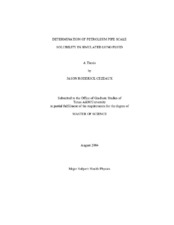| dc.description.abstract | Naturally occurring radioactive material (NORM) exists in connate waters and, under the right conditions during oil drilling, can plate out on the interior surfaces of oil and gas industry equipment. Once deposited, this material is commonly referred to as ??scale.?? This thesis is concerned with the presence of 226Ra in scale deposited on the inner surfaces of oil drilling pipes and the internal dose consequences of inhalation of that scale once released. In the process of normal operation, barium sulfate scale with a radium component adheres to the inside of downhole tubulars in oil fields. When crude flow is diminished below acceptable operational requirements, the pipe is sent to a descaling operation to be cleaned, most likely by a method known as rattling. The rattling process generates dust. This research investigated the chemical composition of that aerosol and measured the solubility of pipe scale from three oilfield formations.
Using standard in-vitro dissolution experimental equipment and methods, pipe scale is introduced into simulated lung fluid over a two-week period. These samples are analyzed using quadrupole inductively coupled plasma mass spectrometry (Q-ICP-MS), known for very low detection limits. Analysis reveals virtually no 226Ra present in the lung fluid exposed to pipe scale. Sample measurements were compared against background measurements using Student??s t test, which revealed that nearly all the samples were statistically insignificant in comparison to the lung fluid blanks. This statistical test proves within a 95% confidence interval that there is no 226Ra present in the lung fluid samples. These results indicate that inhaled NORM pipe scale should be classified as Class S and serve to further confirm the extreme insolubility of petroleum pipe scale.
For dose calculations, the S classification means that the lung is the main organ of concern. Radium-226 from petroleum pipe scale does not solubilize in the interstitial lung fluid, and does not, therefore, enter the bloodstream via respiratory pathways. Since there is no removal by dissolution, the 500 day biological half-life implied by the S classification is based solely on the mechanical transport of 226Ra out of the lungs by phagocytosis or the mucociliary escalator. | en |


